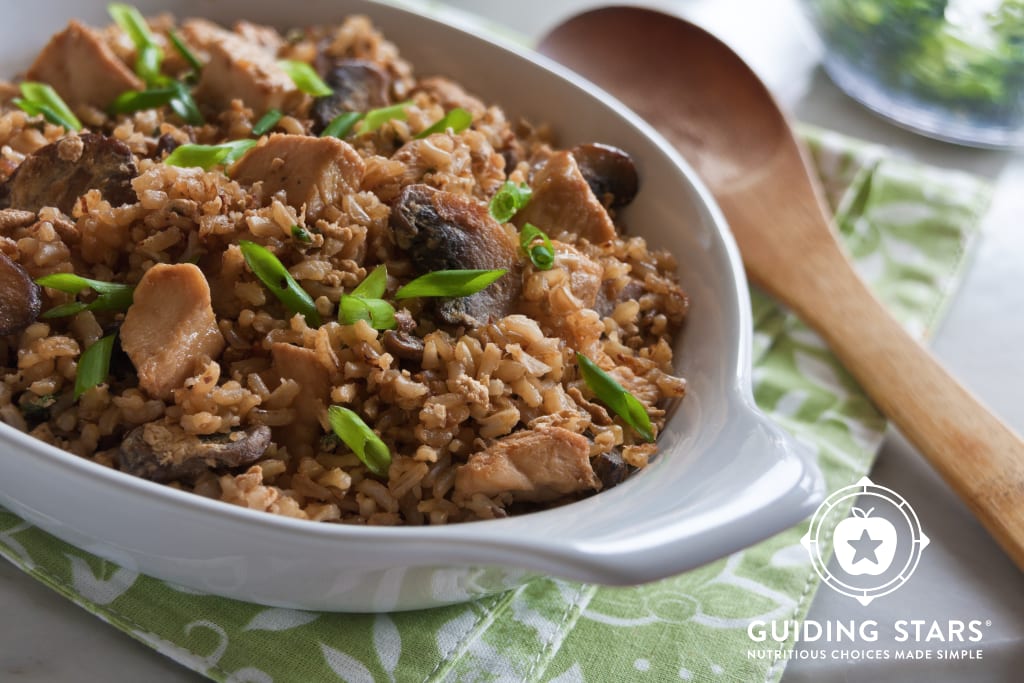
Rice is the epitome of a pantry staple. It’s a basic, inexpensive ingredient, with a long shelf life, that’s easy-to-use in a variety of ways. In fact, rice is a main staple in over 100 countries worldwide. By keeping this sure-to-please grain on hand, you’re well on your way to creating a delicious dish. For this month’s Nutritious Nudge, I want to share some reasons why brown rice is worthy of staple status in your pantry.
Brown Rice Nutrition
Including more whole grains in your diet, and limiting refined grain products, can improve your overall nutrition. It’s easy to swap in whole grains by using brown rice instead of white rice. Brown rice is a whole grain because it’s less processed. Only the inedible outer hull is removed, but the nutritious bran and germ remain.
White rice is not considered a whole grain because its hull, bran, and germ are all removed during processing. Most of the naturally occurring B vitamins, minerals, phytochemicals, and fiber are lost and only the starchy white endosperm remains. B vitamins and iron can be added back in to white rice, but not as much as existed naturally. When nutrients are added back in, it’s indicated by the term “enriched” on food labels and packaging. It’s important to note that fiber is not added back in to enriched white rice. That’s why brown rice keeps you full longer. It has the natural fiber and without it, white rice is processed more quickly in your body.
Essentially, brown rice is the more nutrient-dense option here. As a result, brown rice products typically earn more Guiding Stars than enriched white rice products. Other ingredients, however, can be added to these foods that negatively impact their overall nutrition. For example, some brown rice dishes may come with high-sodium flavor packets. Yet another reason why you should look for Guiding Stars as you shop.
Ways to Use Brown Rice
Brown rice has a nutty flavor and chewy texture. You can substitute it for white rice in nearly any dish, so mix it in whenever you can. With just a few other ingredients, you can use brown rice to create a simple side dish, an exciting entrée, or even a delicious dessert. Leftover brown rice is just as versatile. Use it to add bulk to your soup or a hearty bite to your salad.
It’s worth noting that brown rice cooks slower than white rice, unless you purchase more expensive quick-cooking or instant varieties. Those can be packed with salt and other seasonings though. Look for Guiding Stars for the good, better and best options in terms of nutrition.
Discover tasty ways to use brown rice here.
How to Store Brown Rice
Uncooked brown rice should be stored in a tightly closed container at room temperature. Its storage time is shorter than white rice because it contains more oil. If moisture is kept out, it should maintain good quality for up to 6 months on the shelf. You can store cooked brown rice in the refrigerator for 3 to 5 days. Cooked brown rice keeps for up to 6 months in the freezer in an airtight container.
Other Varieties Can Fit
Brown rice is a nutritious whole grain that can of course be part of a balanced diet, but other rice varieties can fit too. Black, purple, and red rice are other whole grain options, but there’s no need to avoid white rice all together either. The goal is to make half your grains whole grains. Some white rice varieties are synonymous with delicious international dishes like steamed rice in China, risotto in Italy, rice and beans in Mexico, paella in Spain, and jambalaya in the southern U.S. White rice can absolutely fit into a healthy diet when fiber and whole grains are consumed from other foods such as fruits and vegetables and whole wheat bread.